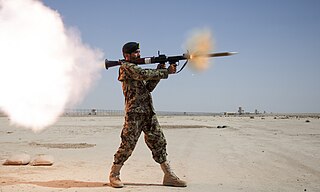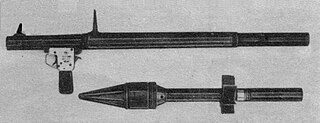
A grenade launcher is a weapon that fires a specially designed, large-caliber projectile, often with an explosive, smoke, or gas warhead. Today, the term generally refers to a class of dedicated firearms firing unitary grenade cartridges. The most common type are man-portable, shoulder-fired weapons issued to individuals, although larger crew-served launchers are issued at higher levels of organization by military forces.

Shoulder-fired missile, shoulder-launched missile or man-portable missile, among other variants, are common slang terms to describe high-caliber shoulder-mounted weapons systems; that is, weapons firing large, heavy projectiles ("missiles"), typically using the backblast principle, which are small enough to be carried by a single person and fired while held on one's shoulder. The word "missile" in this context is used in its original broad sense of a heavy projectile, and encompasses all shells and rockets, guided or unguided. A more formal variant is simply shoulder-fired weapons system and the like.

The Vietnam War involved the People's Army of Vietnam (PAVN) or North Vietnamese Army (NVA), National Liberation Front for South Vietnam (NLF) or Viet Cong (VC), and the armed forces of the People's Liberation Army (PLA), Army of the Republic of Vietnam (ARVN), United States Armed Forces, Republic of Korea Armed Forces, Armed Forces of the Philippines, Royal Thai Armed Forces, Australian Defence Force, and New Zealand Defence Force, with a variety of irregular troops.

The RPG-2 is a man-portable, shoulder-fired anti-tank weapon that was designed in the Soviet Union. It was the first successful anti-tank weapon of its type, being a successor to the earlier and unsuccessful rocket-propelled grenade RPG-1.

The M40 recoilless rifle is a portable, crew-served 105 mm recoilless rifle made in the United States. Intended primarily as an anti-tank weapon, it could also be employed in an antipersonnel role with the use of an antipersonnel-tracer flechette round. The bore was commonly described as being 106 mm caliber but is in fact 105 mm; the 106 mm designation was intended to prevent confusion with incompatible 105 mm ammunition from the failed M27. The air-cooled, breech-loaded, single-shot rifle fired fixed ammunition and was used primarily from a wheeled ground mount or M92 ground mount. It was designed for direct firing only, and sighting equipment for this purpose was furnished with each weapon, including an affixed M8C .50 cal spotting rifle.
The Zastava M70 is a 7.62×39mm assault rifle developed in the Socialist Federal Republic of Yugoslavia by Zastava Arms. The M70 was an unlicensed derivative of the Soviet AK-47. Due to political differences between the Soviet Union and Yugoslavia at the time, namely the latter's refusal to join the Warsaw Pact, Zastava was unable to directly obtain the technical specifications for the AK and opted to reverse engineer the weapon type. Although the M70 was functionally identical to the AK, it had unique in-built features that better enabled it to fire rifle grenades. These included a thicker receiver, a new latch for the dust cover to ensure it would not be jarred loose by a grenade discharge, and a folding grenade sight bracket over the rifle's gas block, which also shut off the gas system when raised.

The Cambodian Civil War was a military conflict that pitted the guerrilla forces of the Maoist-oriented Communist Party of Kampuchea and the armed and security forces of the Nonaligned Kingdom of Cambodia from 1967 to 1970, then between the joint Monarchist, Maoist and Marxist-Leninist National United Front of Kampuchea alliance and the pro-western Khmer Republic from 1970 to 1975. Main combatants comprised:

The M60 recoilless gun is an 82-mm antitank recoilless gun developed in the former Yugoslavia. It entered service with the Yugoslav People's Army during the 1960s.
The high–low system is a design of cannon and anti-tank warfare launcher using a smaller high-pressure chamber to store propellant. It allows a much larger projectile to be launched without the heavy equipment usually needed for large caliber weapons. When the propellant is ignited, the higher pressure gases are bled out through vents at reduced pressure to a much larger low pressure chamber to push a projectile forward. The high-low system allows the weight of the weapon and its ammunition to be reduced significantly. Production cost and time are drastically lower than for standard cannon or other small-arm weapon systems firing a projectile of the same size and weight. It has a far more efficient use of the propellant, unlike earlier recoilless weapons, where most of the propellant is expended to the rear of the weapon to counter the recoil of the projectile being fired.
The Zastava M59/66 PAP is a Yugoslavian licensed derivative of the Soviet SKS semi-automatic rifle. In Yugoslavia, it received the popular nickname "papovka" derived from PAP, the abbreviation for poluautomatska puška, or Serbo-Croatian for "semi-automatic rifle". The M59/66 functions identically to the SKS, but has a permanently attached grenade launcher spigot that also serves as a muzzle brake. The weapon was also produced with a folding grenade launcher sight which is normally folded flat behind the front sight.
The Salvadoran Civil War was a military conflict that pitted the guerrilla forces of the left-wing Marxist-oriented Farabundo Marti National Liberation Front (FMLN) against the armed and security forces loyal to the military-led conservative government of El Salvador, between 1979 and 1992. Main combatants comprised:

The Laotian Civil War was a military conflict that pitted the guerrilla forces of the Marxist-oriented Pathet Lao against the armed and security forces of the Kingdom of Laos, led by the conservative Royal Lao Government, between 1960 and 1975. Main combatants comprised:

Man-portable anti-tank systems are traditionally portable shoulder-launched projectile systems firing heavy shell-type projectiles, typically designed to combat protected targets, such as armoured vehicles, field fortifications and at times even low-flying aircraft.

The STRIM 65 is an anti-tank rifle grenade that the French Army used from 1961 to 1978, under the designation 65 AC 28. This and the older 73mm Modèle 1950 were the standard anti-tank munitions in French service. A 22 mm grenade launching adapter mounted atop the rifle's barrel held the grenade until the firing of a ballistite (blank) cartridge provided the propulsive force to launch the grenade.

The Modèle 1952 34mm HE rifle grenade was in French service from 1952 to 1978. It was used alongside the APAV40 rifle grenade in French service. It was propelled by being mounted atop a rifle's 22 mm grenade launching adapter, and being launched by a ballistite (blank) cartridge.
The Spanish munitions company Instalaza made two models of rifle grenade during the 1960s. As well as being used by the Spanish Army, the Portuguese Army also used them in the colonial wars that took place in its colonies in Africa.

The STRIM 40 is an anti-personnel rifle grenade of French design and manufacture.
This page is based on this
Wikipedia article Text is available under the
CC BY-SA 4.0 license; additional terms may apply.
Images, videos and audio are available under their respective licenses.












